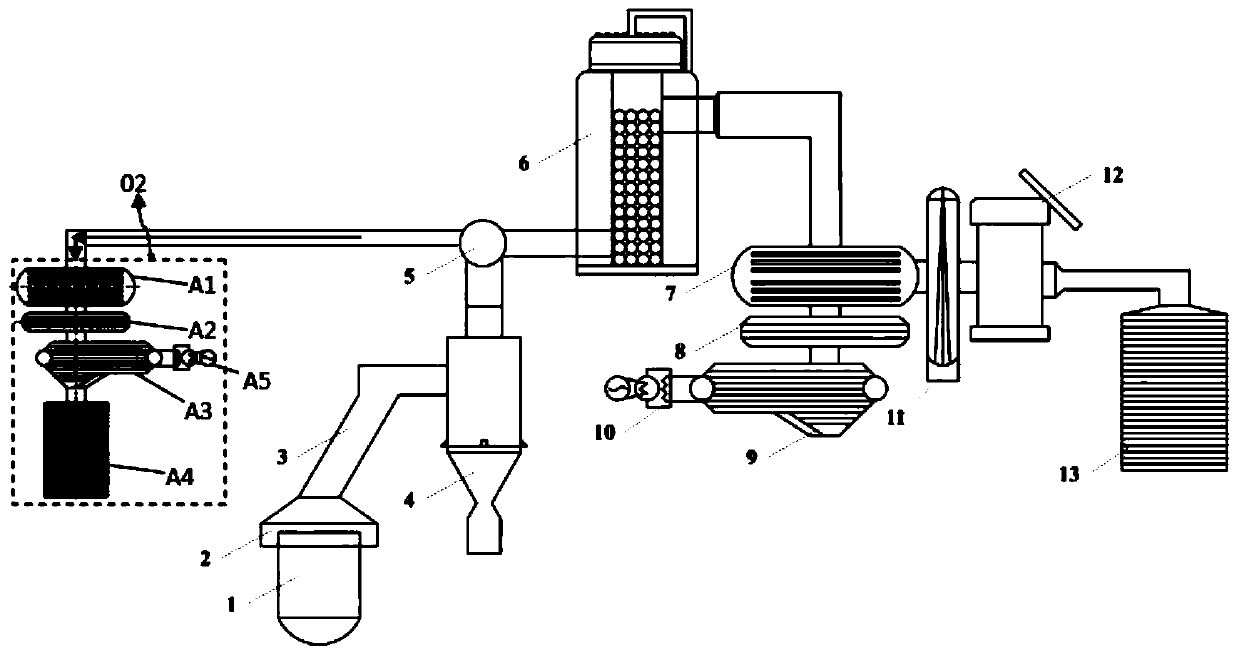Composite system and method for converter flue gas treatment and reduction of all-vanadium-titanium pellets
A converter flue gas and composite system technology is applied in the field of iron and steel metallurgy production, which can solve the problems of physical heat and chemical latent heat loss, large consumption and high emission rate, and achieve the effect of saving energy consumption, production cost and fast process.
- Summary
- Abstract
- Description
- Claims
- Application Information
AI Technical Summary
Problems solved by technology
Method used
Image
Examples
Embodiment 1
[0061] After the high-temperature flue gas (1400°C) produced by the steelmaking converter is vaporized and cooled and the high-temperature cyclone dust is removed, the temperature of the flue gas is reduced to 900°C, and the dust is reduced from 100g / Nm 3 Reduced to 10g / Nm 3 . After the CO concentration automatic detector, the concentration of CO in the flue gas is 20%, and the flue gas is passed into the gas-based reduction shaft furnace at a rate of 2.5L / min, and the chromium-containing all-vanadium-titanium pellets in the gas-based reduction shaft furnace The ore undergoes a reduction reaction for 30 minutes. After the reaction is completed, the flue gas is introduced from the gas outlet of the gas-based reduction shaft furnace to the convective heat exchanger for the next step of treatment. The reduction rate of chromium-containing all-vanadium-titanium pellets was measured to be 68.34%.
Embodiment 2
[0063] After the high-temperature flue gas (1500°C) produced by the steelmaking converter is vaporized and cooled and the high-temperature cyclone dust is removed, the flue gas temperature is reduced to 950°C, and the dust is reduced from 80g / Nm 3 Reduced to 8g / Nm 3 . After the CO concentration automatic detector, the concentration of CO in the flue gas is 30%, and the flue gas is passed into the gas-based reduction shaft furnace at a rate of 3L / min, and the chromium-containing all-vanadium-titanium pellets in the gas-based reduction shaft furnace Carry out the reduction reaction for 30 minutes. After the reaction is completed, the flue gas is introduced from the gas outlet of the gas-based reduction shaft furnace to the convective heat exchanger for the next step of treatment. The reduction rate of chromium-containing all-vanadium-titanium pellets was measured to be 77.21%.
Embodiment 3
[0065] After the high-temperature flue gas (1600°C) produced by the steelmaking converter is vaporized and cooled and the high-temperature cyclone dust is removed, the temperature of the flue gas is reduced to 1000°C, and the dust is reduced from 60g / Nm 3 Reduced to 5g / Nm 3 . After the CO concentration automatic detector, the concentration of CO in the flue gas is 40%, and the flue gas is passed into the gas-based reduction shaft furnace at a rate of 4L / min, and the chromium-containing all-vanadium-titanium pellets in the gas-based reduction shaft furnace Carry out the reduction reaction for 30 minutes. After the reaction is completed, the flue gas is introduced from the gas outlet of the gas-based reduction shaft furnace to the convective heat exchanger for the next step of treatment. The reduction rate of the chromium-containing all-vanadium-titanium pellets was measured to be 92.34%.
PUM
 Login to View More
Login to View More Abstract
Description
Claims
Application Information
 Login to View More
Login to View More - R&D
- Intellectual Property
- Life Sciences
- Materials
- Tech Scout
- Unparalleled Data Quality
- Higher Quality Content
- 60% Fewer Hallucinations
Browse by: Latest US Patents, China's latest patents, Technical Efficacy Thesaurus, Application Domain, Technology Topic, Popular Technical Reports.
© 2025 PatSnap. All rights reserved.Legal|Privacy policy|Modern Slavery Act Transparency Statement|Sitemap|About US| Contact US: help@patsnap.com


